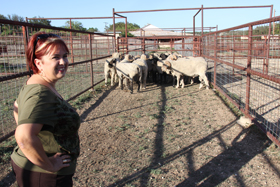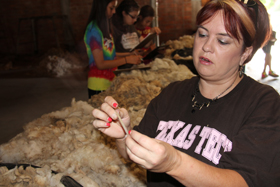
- August 2014
- President’s Notes
- Market Report
- Letters to Vilsack Express Industry Concern Over Grazing Allotments
- Sheep Experiment Station Granted New Life
- News Briefs
- Amidst Drought and Predators, Some Texas Wool-Sheep Producers Vow to Stick it Out
- Ohio Sheep Day: Annual Event’s Goal is to Keep Sheep State’s Infrastructure Shipshape
- Let’s Grow: New Mexico Hoping Taylor Ranch Flock Can Help Turn Back the Sheep Clock
- Researcher With Interest in Feed Value of Woody Plants is ASI Scholarship Winner
- Moving Forward in Montana
- Lamb Board’s Direct Marketing Study Aimed at Helping Industry Understand Growing Sector
Amidst Drought and Predators, Some Texas Wool-Sheep Producers Vow to ‘Stick it Out’
 SONORA, Texas — Inside the once-bustling Sonora Wool Warehouse, Tammy Fisher spent a summer morning directing a handful of young 4-H members who were preparing for an upcoming state wool judging competition.
SONORA, Texas — Inside the once-bustling Sonora Wool Warehouse, Tammy Fisher spent a summer morning directing a handful of young 4-H members who were preparing for an upcoming state wool judging competition.
Such an experience is bittersweet for “coach” Fisher, who admits that wool doesn’t draw the interest it once did here – here being what was once considered the center of the region’s wool universe.
“That’s one reason I’m doing this, maybe we can get some of this next generation back into wool,” Fisher, who returned home to Sonora to open her own law practice and also help keep her family’s sheep ranching heritage alive. Fisher is among wool growers in the area who are “sticking it out,” as she puts it. For various reasons, over the past decade, more and more ranchers in the region have turned to hair sheep and other stock.
“I’m about wool sheep, fine wool sheep, because that’s what I grew up with and that’s what I do,” she said. “For others, dorpers are the answer. To be honest, it’s not easy for any of us right now.”
Right now, even as predator issues continue – the emergence of feral swine at the top of the “worry” list – a common concern for all sheep producers in Texas is one of the most basic agriculture necessities.
Water.
Water makes the ranch go ‘round
Earlier this summer, Sutton County was one of six counties designated as primary disaster counties.
As of late July, bout 61 percent of Texas remained in moderate to exceptional drought ,with about 27 percent transitioning either into or out of drought.
“Sheep producers were already dealing with a number if issues, then the drought here accelerated,” Fisher said. “It caused people to change the way they run their operations, and the effects are being felt. And who knows when the water will return?”
Although Sutton County – of which Sonora is the seat and, actually, its only town, – has had recent rains, there are no signs that the multi-year drought is over.
Like any other agricultural area, water is the heart and soul, and farming and ranching is by far the biggest consumer of Texas water.
Sutton County, which sits on the rolling-to-hilly western edge of the Edwards Plateau region of Texas, has virtually no surface water. It relies on groundwater provided primarily by the Edwards-Trinity Aquifer. Rains have been scarce over the past few years, which has forced local ranchers to alter their operations.

“Virtually all our region’s livestock producers had to reduce their herds in 2011 due to the severe drought and record-breaking heat,” explained Pascual Hernandez, Texas AgriLife Extension agent in Sutton County. “Ranchers and farmers lost their pastures, lost access to quality grasses. Hay became scarce and expensive.”
While conditions have improved somewhat this year due to summer rains, most pastures are still in poor condition, Hernandez said.
“They haven’t improved enough for ranchers to think about re-stocking their herds and flocks,” he added. “When it comes to grazing lands and hay fields, drought recovery takes more than a band-aid. It’s a long process.”
Effects on ranchers
Some ranchers were forced to sell their livestock because the prolonged drought has wreaked havoc on their grazing lands.
Unlike counties to the north that have richer soil and are more conducive to farming, agriculture this part of Texas is suited strictly for ranching.
“It’s [drought] probably a bigger deal for ranchers,” Hernandez said. “Ranchers are strictly at the mercy of rainfall, and agriculture in Sutton County is 95 percent ranching.”
Many sheep producers in the area also raise goats. In fact, Sutton County, with its rocky and hilly terrain, holds the distinction as the top U.S. county for goat production.
Hernandez estimated that goat herds were down about 50 percent since the 2011 drought.
A hidden effect of drought is what it does to predator behavior. Hernandez noted that predators like coyotes, bobcats and feral swine tend to move differently during drought, adding to the pressure put on sheep.
Few livestock industries spared
In the past decade, drought and the decline of finewool sheep and Angora goats has changed the agriculture landscape in Sutton County and surrounding areas. Sheep numbers have followed a national trend in decreasing. Angora goat herds have dropped dramatically over the past two decades. Cattle production had been somewhat stable prior to the recent drought, but is also in a downward pattern.
Many ranchers, including Fisher, have buffered themselves from profit loss by participating in hunting enterprises. Ranchers enter lease contracts with hunting groups and individuals in what has become a win-win for both sides.
“Deer hunting is a big business and we have quality deer on our land,” Fisher explained. “It’s really been something that has helped on the business end. It’s helped keep us going in some respects.”
Fisher plans to ‘stick it out’
Her father, Glen Fisher, is one of the more well-known ranchers, not only in Sutton County but in the state of Texas and across the country. And Tammy Fisher also has a brother raising sheep on family land outside of Sonora,
But Tammy is trying to carve out her own niche, despite the drought and other issues facing the sheep industry. Having spent many years working on agriculture policy in Washington, D.C. before coming home, she keeps a thumb on the pulse of the business.
“Right now I’m running about 280 ewes, which is down a bit from normal, but I have worked hard to sustain my numbers throughout he drought,” Fisher said. “It’s not what it could be, but I’m not going the other direction, I’m not getting out. I’m pretty dedicated to wool sheep, even if that puts me in the minority.”
Back inside the once-bustling Sonora Wool Warehouse, out of the baking Texas summer sun, Fisher tries to explain some of the key points of judging wool to a group of youngsters – youngsters who could never understand what wool once meant to the town, county and region they call home.
“I’m sincerely hoping some of them stick with it,” Fisher said.

